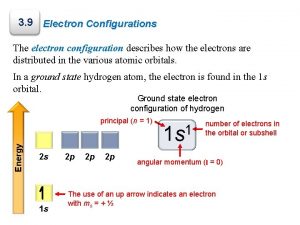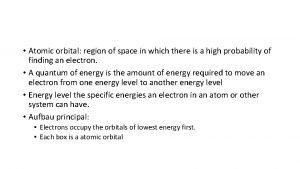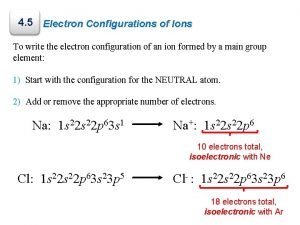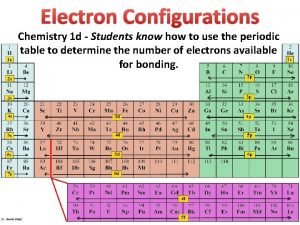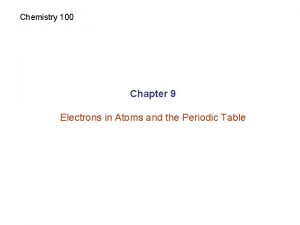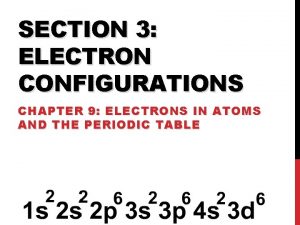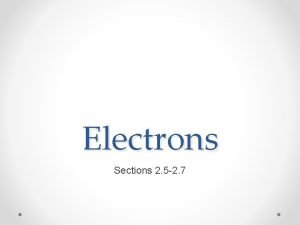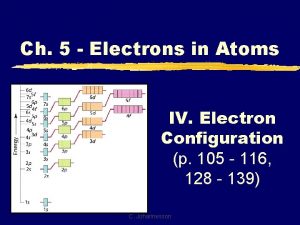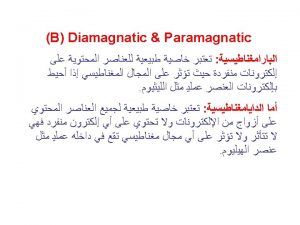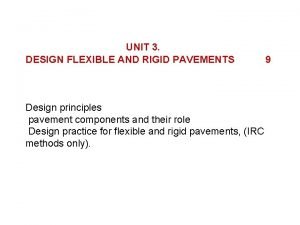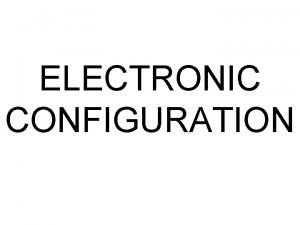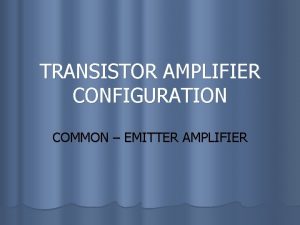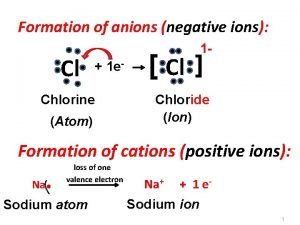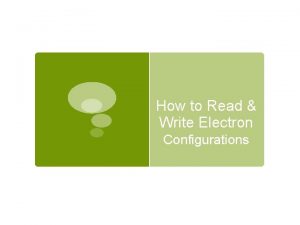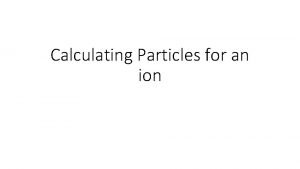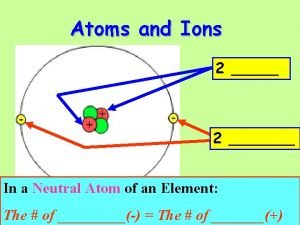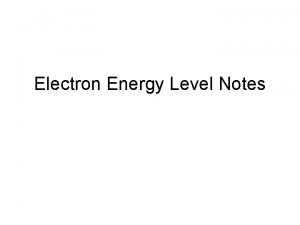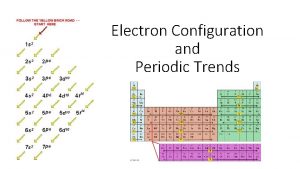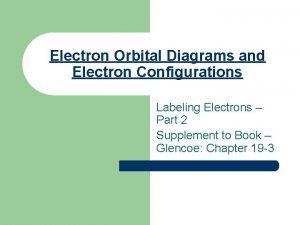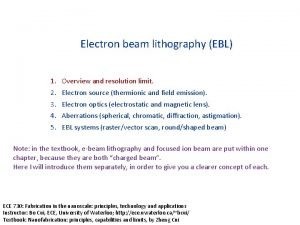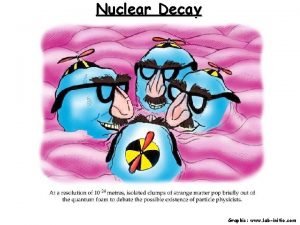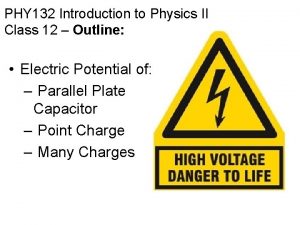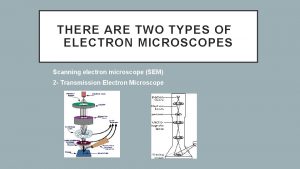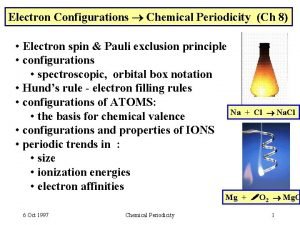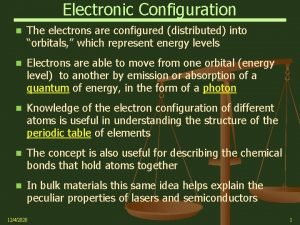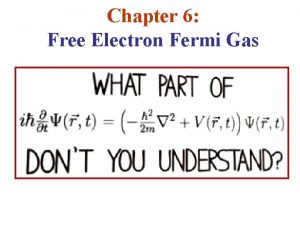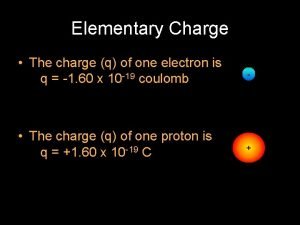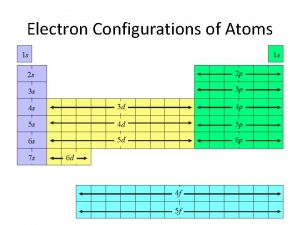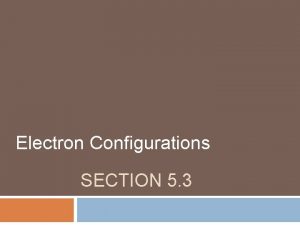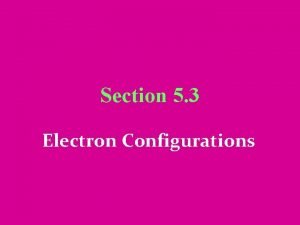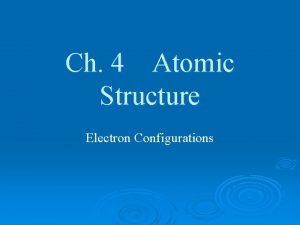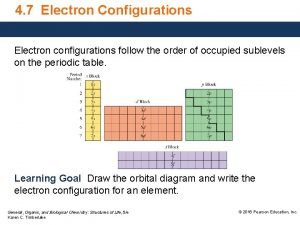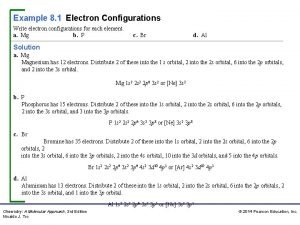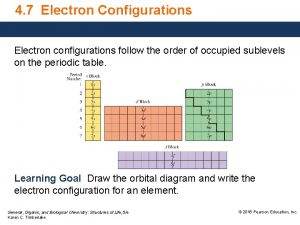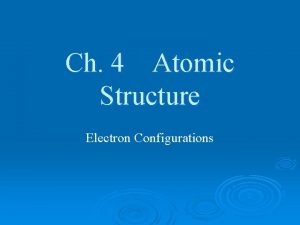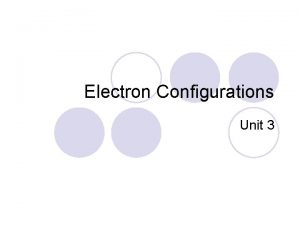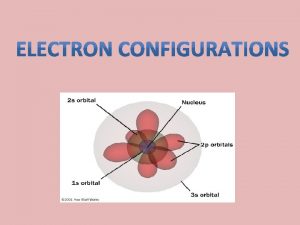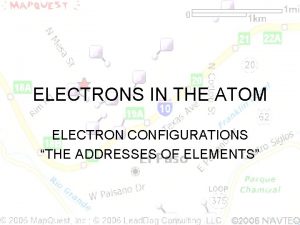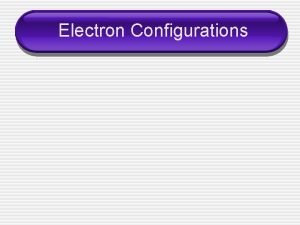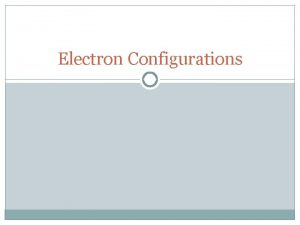Electron Configurations Electrons in an atom Electrons in


















































- Slides: 50

Electron Configurations

Electrons in an atom

Electrons in an atom • Energy level - the ring of electrons an electron is found in.

Electrons in an atom • Energy level - the ring of electrons an electron is found in. • Sublevel – the specific shaped cloud that the electron is found in.

1 st Energy Level The first energy level contains just one sublevel. It is an s-sublevel.

2 nd Energy Level The 2 nd energy level has two sublevels, an s and a p-shaped sublevel.

3 rd Energy Level • The 3 rd energy level contains 3 sublevels.

3 rd Energy Level • The 3 rd energy level contains 3 sublevels. • s, p, and d (the shape of the d-sublevel is more complicated)

Energy Levels 4 -7 • The 4 th-7 th energy levels contains 4 sublevels each.

Energy Levels 4 -7 • The 4 th-7 th energy levels contains 4 sublevels each. • s, p, d, and f (the shape of the f-sublevel is also very complicated)

Electrons in an atom • Energy level - the ring of electrons an electron is found in. • Sublevel – the specific shaped cloud that the electron is found in. • Orbital - a region of the sublevel that can be occupied by no more than 2 electrons.

Orbitals • An ‘s’ sublevel has just one orbital.

Orbitals • An ‘s’ sublevel has just one orbital. • A maximum of 2 electrons can be found in an ‘s’ sublevel.

• A ‘p’ sublevel consists of 3 orbitals that are perpendicular to one another.

• A ‘p’ sublevel consists of 3 orbitals that are perpendicular to one another. • With 3 orbitals, a ‘p’ sublevel can hold a maximum of 6 electrons.

• A ‘d’ sublevel contains a total of 5 orbitals.

• A ‘d’ sublevel contains a total of 5 orbitals. • The maximum number of electrons in a ‘d’ sublevel is 10.

• An ‘f’ sublevel contains a total of 7 orbitals.

• An ‘f’ sublevel contains a total of 7 orbitals. • The maximum number of electrons in a ‘f’ sublevel is 14.

Summary of electron clouds Energy Level Sublevels Present 1 1 s 2 3 4 5 6 7 Maximum # of electrons

Summary of electron clouds Energy Level Sublevels Present Maximum # of electrons 1 1 s 2 2 3 4 5 6 7

Summary of electron clouds Energy Level Sublevels Present Maximum # of electrons 1 1 s 2 2 2 s, 2 p 3 4 5 6 7

Summary of electron clouds Energy Level Sublevels Present Maximum # of electrons 1 1 s 2 2 2 s, 2 p 8 3 4 5 6 7

Summary of electron clouds Energy Level Sublevels Present Maximum # of electrons 1 1 s 2 2 2 s, 2 p 8 3 3 s, 3 p, 3 d 4 5 6 7

Summary of electron clouds Energy Level Sublevels Present Maximum # of electrons 1 1 s 2 2 2 s, 2 p 8 3 3 s, 3 p, 3 d 18 4 5 6 7

Summary of electron clouds Energy Level Sublevels Present Maximum # of electrons 1 1 s 2 2 2 s, 2 p 8 3 3 s, 3 p, 3 d 18 4 4 s, 4 p, 4 d, 4 f 5 6 7

Summary of electron clouds Energy Level Sublevels Present Maximum # of electrons 1 1 s 2 2 2 s, 2 p 8 3 3 s, 3 p, 3 d 18 4 4 s, 4 p, 4 d, 4 f 32 5 6 7

Summary of electron clouds Energy Level Sublevels Present Maximum # of electrons 1 1 s 2 2 2 s, 2 p 8 3 3 s, 3 p, 3 d 18 4 4 s, 4 p, 4 d, 4 f 32 5 5 s, 5 p, 5 d, 5 f 6 7

Summary of electron clouds Energy Level Sublevels Present Maximum # of electrons 1 1 s 2 2 2 s, 2 p 8 3 3 s, 3 p, 3 d 18 4 4 s, 4 p, 4 d, 4 f 32 5 5 s, 5 p, 5 d, 5 f 32 6 7

Summary of electron clouds Energy Level Sublevels Present Maximum # of electrons 1 1 s 2 2 2 s, 2 p 8 3 3 s, 3 p, 3 d 18 4 4 s, 4 p, 4 d, 4 f 32 5 5 s, 5 p, 5 d, 5 f 32 6 6 s, 6 p, 6 d, 6 f 32 7 7 s, 7 p, 7 d, 7 f 32

Diagonal Rule • The diagonal rule allows you to determine the order in which sublevels will be filled with electrons.

Diagonal Rule • The diagonal rule allows you to determine the order in which sublevels will be filled with electrons. • Begin by writing out all of the possible sublevels in 4 columns, one for each letter.


Diagonal Rule • The diagonal rule allows you to determine the order in which sublevels will be filled with electrons. • Begin by writing out all of the possible sublevels in 4 columns, one for each letter. • Starting at the top, draw parallel diagonal lines so that each sublevel is crossed.


Electron configuration for Titanium • Titanium (22 electrons)

Electron configuration for Titanium • Titanium (22 electrons) • Start filling the sublevels in the order that the arrows indicate.

Electron configuration for Titanium • Titanium (22 electrons) • Start filling the sublevels in the order that the arrows indicate.

Electron configuration for Titanium • Titanium (22 electrons) • Start filling the sublevels in the order that the arrows indicate.

Electron configuration for Titanium • Titanium (22 electrons) • Start filling the sublevels in the order that the arrows indicate.

Electron configuration for Titanium • Titanium (22 electrons) • Start filling the sublevels in the order that the arrows indicate.

• Continue until all 22 electrons are accounted for.

• Continue until all 22 electrons are accounted for. • 1 s 22 p 63 s 23 p 64 s 23 d 2

• Continue until all 22 electrons are accounted for. • 1 s 22 p 63 s 23 p 64 s 23 d 2 • Even though the d sublevel can hold 10 electrons, we only had 2 electrons left.

• Continue until all 22 electrons are accounted for. • 1 s 22 p 63 s 23 p 64 s 23 d 2 • Even though the d sublevel can hold 10 electrons, we only had 2 electrons left. • Being in period 4, the 4 th energy level is the valence level for titanium.

• Continue until all 22 electrons are accounted for. • 1 s 22 p 63 s 23 p 64 s 23 d 2 • Even though the d sublevel can hold 10 electrons, we only had 2 electrons left. • Being in period 4, the 4 th energy level is the valence level for titanium. • The two electrons in the 4 s sublevel are valence electrons.

Checking for accuracy • 1 s 22 p 63 s 23 p 64 s 23 d 2

Checking for accuracy • 1 s 22 p 63 s 23 p 64 s 23 d 2 • The d in the last term means we should find titanium in the d-block of the periodic table (groups 3 -12).

Checking for accuracy • 1 s 22 p 63 s 23 p 64 s 23 d 2 • The d in the last term means we should find titanium in the d-block of the periodic table (groups 3 -12). • The exponent 2 indicates that it should be in the 2 nd column of the d-block (group 4).

Checking for accuracy • 1 s 22 p 63 s 23 p 64 s 23 d 2 • The d in the last term means we should find titanium in the d-block of the periodic table (groups 3 -12). • The exponent 2 indicates that it should be in the 2 nd column of the d-block (group 4). • The energy level (3) indicates the period number for the element if it is in the s or p block. The d block is always one period behind and the f block is 2 behind. Titanium should be in period 4.
 The most stable arrangement of electrons is
The most stable arrangement of electrons is An orbital is a region of space in an atom where there is
An orbital is a region of space in an atom where there is Electron configuration and periodicity
Electron configuration and periodicity Dot
Dot Calcium ion formula
Calcium ion formula Stable electron configurations
Stable electron configurations Chapter 5 electrons in atoms
Chapter 5 electrons in atoms S electrons
S electrons Electrons configurations
Electrons configurations S orbital
S orbital Valence shell electron configuration
Valence shell electron configuration Electron configuration for oxygen
Electron configuration for oxygen Paramagnetic unpaired electrons
Paramagnetic unpaired electrons Bjt regions
Bjt regions Ceedar innovation configurations
Ceedar innovation configurations Difference between rigid and flexible pavement
Difference between rigid and flexible pavement What do you mean by electronic configuration
What do you mean by electronic configuration Transistor amplifier configurations
Transistor amplifier configurations The formation of negative ions
The formation of negative ions Write the electron configuration for a neutral atom of tin.
Write the electron configuration for a neutral atom of tin. Atom proton neutron electron
Atom proton neutron electron Atomic number of iron
Atomic number of iron How many electrons are in neutral 41ca atom
How many electrons are in neutral 41ca atom The lowest allowable energy state of an atom is called
The lowest allowable energy state of an atom is called Electrons in an atom's outermost orbitals are called
Electrons in an atom's outermost orbitals are called Atomic structure worksheet
Atomic structure worksheet Electrons in atoms section 2 quantum theory and the atom
Electrons in atoms section 2 quantum theory and the atom An atom's ability to attract electrons
An atom's ability to attract electrons Rules governing electronic configuration
Rules governing electronic configuration Democritus teori atom
Democritus teori atom The structure of the atom section 2 defining the atom
The structure of the atom section 2 defining the atom Boron orbital filling diagram
Boron orbital filling diagram Ebl lithography
Ebl lithography Resonance delocalization
Resonance delocalization Calculating half life
Calculating half life Magnitude electric field
Magnitude electric field Types of electron microscope
Types of electron microscope Electron configuration of ci 17
Electron configuration of ci 17 Magnetic dipole moment of electron
Magnetic dipole moment of electron What is molecular geometry
What is molecular geometry Electron charge
Electron charge Shape of p orbital in chemistry
Shape of p orbital in chemistry Advantages and disadvantages of electron beam machining
Advantages and disadvantages of electron beam machining Silicon octet rule
Silicon octet rule 5s 25p6 is the outermost electronic configuration of
5s 25p6 is the outermost electronic configuration of What does aerobic respiration mean
What does aerobic respiration mean Fermi energy formula
Fermi energy formula Granum
Granum Emal umich
Emal umich Elementary charge q
Elementary charge q Parts of electron microscope
Parts of electron microscope
